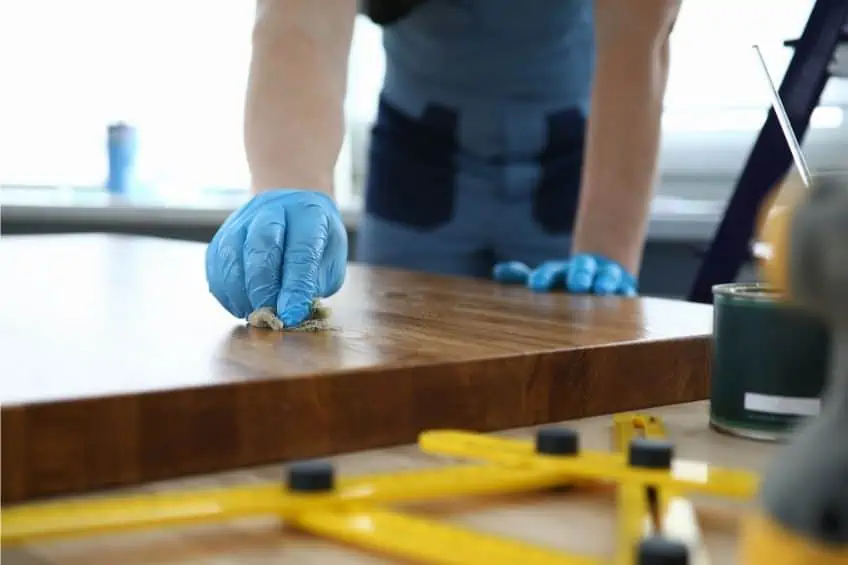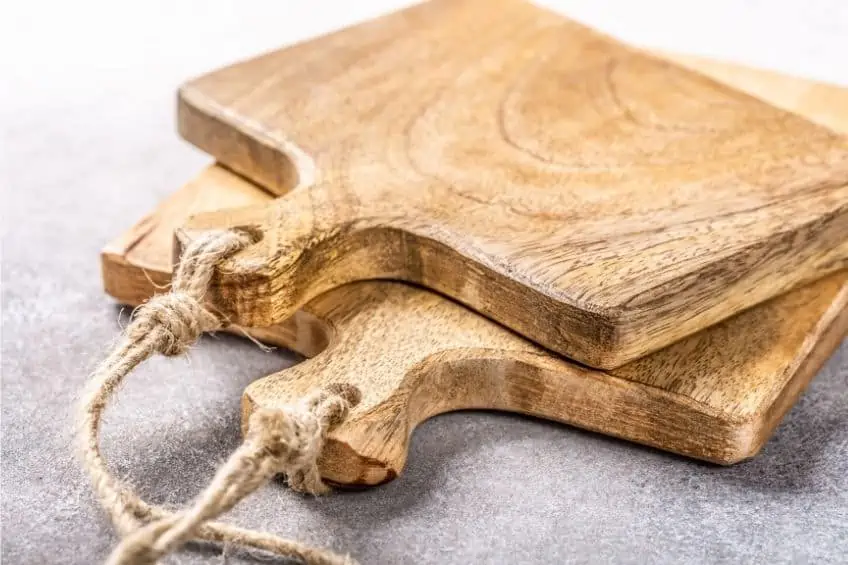Butcher Block Finish – How to Finish Butcher Blocks
This post may contain affiliate links. We may earn a small commission from purchases made through them, at no additional cost to you.
Making a butcher block is a rewarding DIY project to do at home. Butcher blocks and wooden countertops require a special finish in order to protect the wood, maintain the characteristics of the wood, and make the block safe for food use. There are various options for a butcher block finish depending on your project, the wood used, and the kind of look you wish to achieve. We will explore some of these options in detail.
Table of Contents
Understanding Butcher Block Finishes
Wood can be a wonderful choice of material to use in the kitchen. Wood products offer a natural look and feel that you just can’t get from other materials. Using wood for butcher blocks and kitchen counters provides a surface that is equally practical and attractive. Wood offers a certain texture, warmth, and natural beauty that other finishes just dont provide.
Finishing butcher block counters needs to be done properly in order to maintain the appeal of wood, while still providing a layer of protection. A butcher block finish will need to be able to stand up against heavy use, scratches, knives, be suitable for food use, and it might need to have a level of heat resistance. There are various different options for finishing butcher blocks. You will need to be sure to choose one that looks good and is practical, because butcher block surfaces require heavy and quite specific, use.
When looking for a butcher block finish, there is one important question to consider: “will the butcher block be used for cutting on or not?”. If you plan on cutting and preparing food on the block, then you will have to choose a particularly natural or food-safe option. This is because cutting will expose the wood, and can release very small parts of the finish into your food. If you are just using the board to display food, then any finish can work.

Butcher Block Finish Options
There is a wide range of options for finishing butcher block counters. While there are many different products out there that can be used, the most popular options will fall under two categories: oil and polyurethane. Each one has its distinct advantages and disadvantages, and the type that you choose should depend on your specific project.
Sealing butcher blocks with a polyurethane coating provide a harder additional layer over the wood. This coating forms a type of durable film over the wood. Polyurethane is highly resistant and can protect the wood from scratches, moisture, and all kinds of heavy use. This finish can be used as a butcher block sealer as well. It is also clear and shiny which adds a nice effect to the wood. The downside to a polyurethane finish is that it creates a layer over the wood which prevents you from enjoying a direct wooden surface for your butcher block. It also needs to be completely sanded down and removed in order to reapply new coats.
The other popular option is to use wood oil. Wood oils get absorbed directly into the wood and offer a more natural-looking finish. Oils do not provide that sealing layer over the wood, but rather soak into the wood. This helps to protect the wood against damage and improves the natural hue of the wood grain. Wood oils come in a range of different styles and shades depending on the type of wood that you are using.
Many prefer the natural wood oil finish thanks to its favorable properties over the wood. The only issue is that wood oil is not as durable as polyurethane, and it will require more regular maintenance and reapplication. If you will be using the butcher’s block for cutting on, another very good option is to just not add a finish at all. Sure, this will lead to the wood slowly drying out, discoloring, and maybe forming cracks. However, the wood will be completely safe and it will have the completely natural, bare look that many enjoy.

How to Finish Butcher Blocks
Knowing how to finish butcher blocks will depend on the type of finish you are using. There are many different options available, so whichever finish you choose will determine exactly how to treat the wooden surface. However, there are a few basic guidelines to always follow.

Prepare the Surface
Start by making sure that the butcher block is ready and prepared for being finished. You may have to sand down the block to remove any existing finishes, and to get a smooth surface. If you are recoating an old chopping board, try to sand down the chopped surface until it is completely smooth and even. You can only add your finish to completely bare wood.
Then you will need to make sure that the surface is also fully cleaned and dry. Wash the wooden board with soapy water to remove any dirt, dust, or impurities. Dry it off, and make sure that the wood is completely dry before going ahead with the finish.
Applying Mineral Oil
If you are using mineral oil as a butcher block treatment, the application process is pretty easy. Simply rub a copious amount of the oil over the surface of the wood. Be sure to coat the entire surface, rubbing it in with a cloth. Leave the oil to stand for a couple of minutes, then wipe off any excess oil. Then you will need to leave the oil to fully dry and soak in. Once dry, you can apply the next coat. This can be applied as many times as you want until you reach the desired finish.
Applying a Butcher Block Sealer
The other butcher block treatment is to seal the surface with something like polyurethane, varnish, or lacquer that provides a firmer coating over the wood. Sealing butcher blocks like this work well over countertops, but is generally not recommended for cutting boards. Knowing how to seal butcher blocks is quite a careful process.
To apply a sealer like this, you will need to paint it over the surface of the wood. This should be done with a foam brush, roller, or paintbrush. There are also some aerosol spray options available. Just be careful when painting it on, as it could result in brush marks or drips on the butcher block finish. Let the coating dry, and then repeat. You will likely need about three or four coats for the best results.
Maintaining the Butcher Block Finish
No matter how durable the butcher block finish that you have chosen is, you will likely have to maintain and renew it over time. This is particularly true for kitchen counters and chopping boards because of how heavily used these surfaces are.
With a wood oil, you simply need to clean the surface and start to add more layers of oil. Oil may need more regular reapplication, as it can dry out faster. Polyurethane, or other sealers, are more difficult to reapply. You will need to sand off the existing surface completely anmd start again from fresh. However, these surfaces will be longer-lasting.

Frequently Asked Questions
How Can You Make a Food Safe Butcher Block Finish?
Mineral oil and special cutting board oils are available for a food-safe finish. Tung oil is another popular option for a durable but food-safe wood finish. Be sure to check the product that you use to make sure that it is labeled as being food safe and non-toxic.
Should You Seal a Butcher Block?
Sealing a butcher block is important to prevent the wood from drying out, staining, and getting damaged. You can do this with a range of different finishing options. Mineral oil is a good choice.
Can You Seal Butcher Blocks With Polyurethane?
Polyurethane is a great butcher block finish for countertops, as it is clear, durable, and enhances the wood. Polyurethane will create a layer over the wood that you do not get with wood oil.
What Finish Works Best for a Butcher Block?
There are many different butcher block finish options available. Mineral oil is generally the preferred method, as it is food safe and provides a rich protective shine over the wood.
Knowing how to seal butcher blocks allows you to maintain the wood and enhance or restore old, dry wood surfaces. The right butcher block finish will make the surface of your cutting board or countertops look brand new. This is important for keeping the wood protected and looking great. We hope that our guide above has helped you to find the perfect product for your needs.








